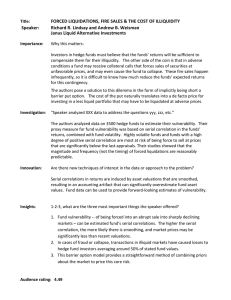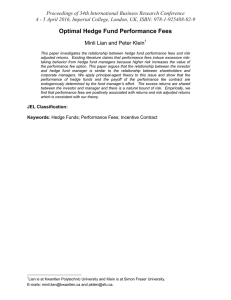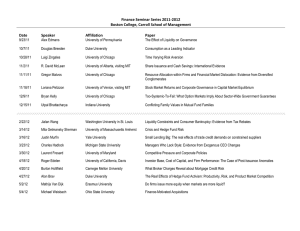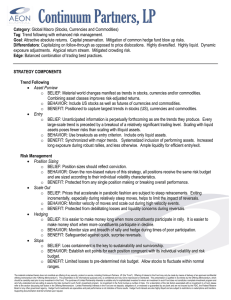The Impact of Hedge Funds on Asset Markets Mathias Kruttli Andrew Patton
advertisement
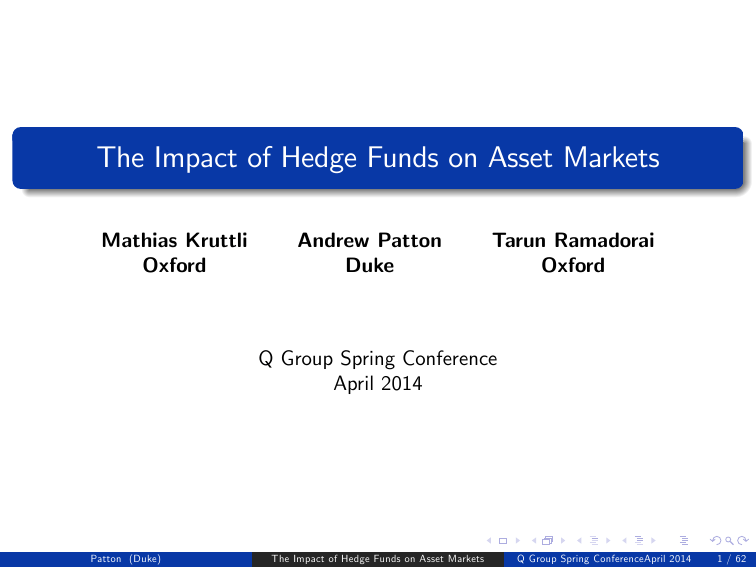
The Impact of Hedge Funds on Asset Markets Mathias Kruttli Oxford Andrew Patton Duke Tarun Ramadorai Oxford Q Group Spring Conference April 2014 Patton (Duke) The Impact of Hedge Funds on Asset Markets Q Group Spring ConferenceApril 2014 1 / 62 Motivation Regulators, investors, and academics are deeply interested in hedge funds The …nancial stability panel established under Dodd-Frank introduced new disclosure regulations in 2012 (“Form PF”) Assets under management has grown from $50 billion in 1990 to $500 billion in 2000, and to $2 trillion in 2013 Scores of academic papers studying hedge funds As of 2013Q3, the hedge fund industry has AUM of about $2 trillion, small compared with mutual funds with around $28 trillion But hedge funds employ substantial leverage and have high trading volume Impact of hedge fund activity may be greater than its AUM suggests F Yet evidence of hedge funds’impact on markets is relatively scarce What we do in this paper We create a simple index of the ability of hedge funds to provide liquidity to asset markets Liquidity provision is thought to be a source of pro…tability for hedge funds Our index is an aggregate measure of the illiquidity of hedge funds’holdings We study the predictive power of our measure of hedge fund illiquidity across 72 assets in three di¤erent asset classes Indices of international equities, US corporate bonds and currencies We present a simple theoretical model of hedge funds’willingness to provide liquidity The model provides additional predictions on where our new illiquidity measure should be particularly useful Main …ndings of the paper We …nd that our simple index of hedge fund illiquidity is a powerful predictor of asset returns In sample: signi…cant for 21/21 international equity indices, 31/42 corporate bond indices, 6/9 currencies Out-of-sample: signi…cantly beats the historical mean model for 20/21 international equity indices, 28/42 corporate bond indices, 3/9 currencies Both in and out of sample, our index is as good or better than best alternative predictor for each asset class Our simple theoretical model of hedge funds willingness to provide liquidity explains our main results, and generates two further predictions Predictive power should be (and is) greater for less liquid assets Predictive power should (and is) greater following negative asset returns Outline Introduction Data description and illiquidity index construction Predictive performance, with and without competitor variables In sample Out of sample A simple model of hedge fund liquidity provision Empirical tests of predictions of the model Robustness checks Conclusion Data description Hedge fund data: we merge …ve databases to construct a universe of around 30,000 hedge funds HFR, TASS, CISDM, Morningstar, BarclayHedge Sample period is January 1994 – December 2011, 216 months of data International equities: 21 country equity indices, from K. French’s web site US corporate bonds: 42 indices, from Bank of America-Merrill Lynch 24 investment grade, 18 high yield Six di¤erent maturity buckets: 1-3, 3-5, 5-7, 7-10, 10-15, 15+ years Currencies: 9 exchange rates, all against the USD, from Bloomberg We use the DM/USD rate in place of the Euro/USD pre-1999 An index of hedge fund illiquidity Getmansky, et al. (2004, JFE) and Lo (2008) propose using autocorrelation in hedge fund returns as a proxy for the illiquidity of their holdings “Marking to model” leads to greater autocorrelation Intentional “performance smoothing” is easier to do when marking to model (“opportunistic smoothing”) Lo (2008) shows that average autocorrelations are higher in HF styles that are ex ante thought to be less liquid We use a simple rolling-window estimate of average autocorrelation as our measure of HF illiquidity: Individual fund i ρ̂i ,t = ρt = 1 ri ,t ∑W j =0 N Index ∑ i =1 j r̄i ,t 1 ri ,t j ∑W j =0 n o ω i ,t max ρ̂i ,t , 0 ri ,t j 1 2 r̄i ,t r̄i ,t The hedge fund illiquidity index over time High illiquidity during the great recession and hedge fund crisis periods Hedge fund illiquidity index 0.35 Quant meltdown 0.3 WorldCom & Enron scandals Illiquidity measure 0.25 0.2 Credit crunch Great Cyprus crisis Recession declared over LTCM crisis 0.15 0.1 0.05 0 Jan95 Jan97 Jan99 Jan01 Jan03 Jan05 Jan07 Jan09 Jan11 Jan13 Outline Introduction Data description and illiquidity index construction Predictive performance, with and without competitor variables In sample Out of sample A simple model of hedge fund liquidity provision Empirical tests of predictions of the model Robustness checks Conclusion A …rst look at predictive power We estimate a single variable predictive regression in-sample: ri ,t +1 = αi + γi ρt + εi ,t +1 where i denotes assets, and t denotes months For equities and corporate bonds, ri ,t +1 is the log excess return For currencies, ri ,t +1 is the log di¤erence in spot rates (Results are very similar when using excess currency returns, i.e., including the interest rate di¤erential) In-sample predictive power: International equities Coe¤ on rho is positive and signi…cant at the 5% level for all 21 markets 2 2 Country R / γ signif / γ sign Country R / γ signif / γ sign Australia Austria Belgium Canada Denmark Finland France Germany Hong Kong Ireland Italy 8.220 3.954 2.608 3.057 2.920 1.327 2.148 1.611 4.638 2.741 1.632 Japan Netherlands New Zealand Norway Singapore Spain Sweden Switzerland UK US 2.745 3.255 4.722 4.509 6.560 3.836 4.022 1.739 4.025 1.583 ** ** ** ** ** ** ** ** ** ** ** Across 21 countries + + + + + + + + + + + ** ** ** ** ** ** ** ** ** ** 3.422 (21/0) + + + + + + + + + + In-sample predictive power: US corporate bonds Coe¤ on rho is positive for all 42 bond indices, and signi…cant for 31 indices Rating/Mat. (# Port.) R 2 Coe¤ is signif and Positive Negative Inv Grade (24) High Yield (18) 3.099 6.364 14 17 0 0 1-3Y (7) 3-5Y (7) 5-7Y (7) 7-10Y (7) 10-15Y (7) 15+Y (7) 3.886 4.995 4.865 4.911 3.244 5.088 5 5 5 6 4 6 0 0 0 0 0 0 Across 42 indices 4.498 31 0 In-sample predictive power: Currencies Coe¤ on rho is positive for all 9 currencies, and signi…cant for 6 currencies 2 Currencies R / γ signif / γ sign Australia Canada Euro Japan New Zealand Norway Sweden Switzerland UK 5.885 4.111 1.406 -0.367 4.565 1.883 1.468 -0.207 -0.001 Across 9 currencies ** ** ** ** ** ** + + + + + + + + + 2.083 (6/0) Competitor predictor variables Next, consider competitor variables for forecasting asset returns: ri ,t +1 = αi + βij Competitorj ,t + εi ,j ,t +1 International Equities: Lagged returns, dividend yield, VIX Innovations (Goyal and Welch, 2008 RFS) US corporate bonds: Lagged returns, Pastor-Stambaugh traded liquidity factor, VIX Innovations, and VWM excess returns on the S&P 500 (Bongaerts, de Jong, and Driessen, 2012, wp) Currencies: In‡ation di¤erential and interest rate di¤erential (Meese and Rogo¤, 1983, AER) F Below I present the results for the best competitor variable for each asset class; results for all competitors are in the paper. In-sample predictive power: Int’l equities with VIX shocks Adj R2 is slightly lower, and coe¤ is signi…cant for 15/21 markets, compared with 21/21 2 2 Country R / β signif / β sign Country R / β signif / β sign Australia Austria Belgium Canada Denmark Finland France Germany Hong Kong Ireland Italy 1.289 8.126 7.597 4.875 6.277 -0.482 2.175 1.679 0.941 3.032 1.967 Japan Netherlands New Zealand Norway Singapore Spain Sweden Switzerland UK US 3.082 5.669 4.000 4.419 1.595 1.343 1.393 4.250 3.978 0.892 ** * * ** * * * * Across 21 countries - ** ** ** ** * ** ** 3.243 (0/15) - In-sample predictive power: US corp bonds with lag rets Adj R2 is similar; coe¤ is signi…cant for 26/42 indices, compared with 31/42 for our index Rating/Mat. (# Port.) R 2 Coe¤ is signif and Positive Negative Inv Grade (24) High Yield (18) 1.816 8.023 12 14 0 0 1-3Y (7) 3-5Y (7) 5-7Y (7) 7-10Y (7) 10-15Y (7) 15+Y (7) 4.205 6.446 5.658 3.978 3.554 3.017 5 6 5 5 3 2 0 0 0 0 0 0 Across 42 indices 4.476 26 0 In-sample predictive power: Currencies with in‡ation di¤ Adj R2 is slightly higher; coe¤ is signi…cant for 6/9 currencies, same as for our index 2 Currencies R / β signif / β sign Australia Canada Euro Japan New Zealand Norway Sweden Switzerland UK 3.316 3.681 6.148 -0.119 4.872 0.065 3.832 4.188 0.132 Across 9 currencies ** ** ** ** ** ** + + + + + + + + + 2.902 (6/0) Including competitor predictor variables Next, we include ρ together with all competitors in a multiple regression: ri ,t +1 = αi + γi ρt + βi Competitorsi ,t + εi ,t +1 Competitors are the same as before: International Equities: Lagged returns, dividend yield, VIX Innovations (Goyal and Welch, 2008 RFS) US corporate bonds: Lagged returns, Pastor-Stambaugh traded liquidity factor, VIX Innovations, and VWM excess returns on the S&P 500 (Bongaerts, de Jong, and Driessen, 2012, wp) Currencies: In‡ation di¤erential and interest rate di¤erential (Meese and Rogo¤, 1983, AER) In-sample multiple predictors: International equities Adjusted R2 increases, but coe¢ cient on rho remains as signi…cant as before 2 2 Country R / γ signif / γ sign Country R / γ signif / γ sign Australia Austria Belgium Canada Denmark Finland France Germany Hong Kong Ireland Italy 10.746 12.239 12.617 7.526 11.129 4.414 3.947 2.990 4.806 6.583 3.897 Japan Netherlands New Zealand Norway Singapore Spain Sweden Switzerland UK US 5.881 8.828 11.606 9.142 7.960 4.443 5.270 5.217 8.396 2.148 ** ** ** ** ** ** ** ** ** ** ** Across 21 countries + + + + + + + + + + + ** ** ** ** ** ** ** ** ** ** 7.133 (21/0) + + + + + + + + + + In-sample, multiple predictors: US corporate bonds Adjusted R2 increases, but coe¢ cient on rho remains as signi…cant as before Rating/Mat. (# Port.) R 2 Coe¤ is signif and Positive Negative Inv Grade (24) High Yield (18) 8.110 25.491 14 17 0 0 1-3Y (7) 3-5Y (7) 5-7Y (7) 7-10Y (7) 10-15Y (7) 15+Y (7) 15.431 18.368 18.373 15.229 12.466 13.493 5 5 5 6 4 6 0 0 0 0 0 0 Across 42 indices 15.560 31 0 In-sample, multiple predictors: Currencies Coe¢ cient on rho is signi…cant for 5/9 rather than 6/9 currencies; two sign changes 2 Currencies R / γ signif / γ sign Australia Canada Euro Japan New Zealand Norway Sweden Switzerland UK 7.187 5.230 5.529 0.633 7.086 1.449 4.698 4.713 0.465 Across 9 currencies ** ** ** ** * + + + + + + + 4.110 (5/0) Multi-step-ahead predictions Next we investigate the predictive power of our hedge fund illiquidity index across forecast horizons from 1 to 12 months We use a “direct projection” approach: ri ,t +h = αi ,h + γi ,h ρt + εi ,t +h ri ,t +h = αi ,h + γi ,h ρt + βi ,h Competitorsi ,t + εi ,t +1 How long does predictability last? Just illiquidity index Predictability is strongest at h=1, but remains strong even out to 6 months How long does predictability last? All predictor variables Predictability is strongest at h=1, but remains strong even out to 6 months Out-of-sample forecasting We now consider the out-of-sample predictive power of our illiquidity index We use a rolling window of 60 months to estimate the model, and predict returns one month ahead Given the short sample, we only include predictor variables one at a time: ri ,t +1 ri ,t +1 = αi + γi ρt + εi ,t +1 = αi + βij Competitorj ,t + εi ,j ,t +1 We compare the OOS forecasts with those from a historical mean return model The signi…cance of the di¤erence between the two forecasts is assessed using an extension of the Clark and West test (2006, JoE), see appendix Out-of-sample forecasting: International equities Signi…cantly beat historical mean for 20/21 countries (just 4/21 for VIX shocks) Country R2OOS / signif Country R2OOS / signif Australia Austria Belgium Canada Denmark Finland France Germany Hong Kong Ireland Italy 9.039 4.366 3.260 2.711 2.680 1.815 2.296 0.720 3.328 2.739 2.311 Japan Netherlands New Zealand Norway Singapore Spain Sweden Switzerland UK US -0.887 3.679 5.764 4.836 3.973 4.569 3.119 0.963 4.653 1.657 All 21 countries ** ** ** ** ** ** ** * ** * ** 3.219 (20) * * ** ** ** ** ** ** * Out-of-sample forecasting: US corporate bonds Signi…cantly beat historical mean for 28/42 indices (17/42 for mkt rets) Rating/Mat. (# Port.) R2OOS Signif Inv Grade (24) High Yield (18) 3.300 5.835 11 17 1-3Y (7) 3-5Y (7) 5-7Y (7) 7-10Y (7) 10-15Y (7) 15+Y (7) 4.343 5.053 4.664 4.594 3.059 4.604 5 4 5 5 4 5 Across 42 indices 4.386 28 Out-of-sample forecasting: Currencies Signi…cantly beat historical mean for 3/9 indices (in‡ation di¤ gets 4/9 at 10% level, worse R2) Currencies R2OOS / signif Australia Canada Euro Japan New Zealand Norway Sweden Switzerland UK 4.098 1.372 -0.405 -4.229 3.545 0.790 -1.365 -2.186 -1.895 Across 9 currencies ** ** ** -0.030 (3) Summary of results so far Our simple index of hedge fund illiquidity: 1 Is better (int’l equities and corporate bonds) or as good (currencies) than the best alternative predictor, in-sample 2 Remains just as signi…cant when all main competitor variables are included in a predictive regression 3 Has predictive power as far out as 6 months, though strongest at 1-2 months 4 Is as good or better better than the best alternative predictor for each of the three asset classes, out-of-sample Outline Introduction Data description and illiquidity index construction Predictive performance, with and without competitor variables In sample Out of sample A simple model of hedge fund liquidity provision Empirical tests of predictions of the model Robustness checks Conclusion Market makers and return reversal We incorporate liquidity constraints into the limits to arbitrage framework of Gromb and Vayanos (2010) The hedge fund e¤ectively acts as a market maker for a risky asset, which is subject to demand shocks from noise traders The hedge fund faces the threat of investors withdrawing funds, and needs to hold su¢ cient liquid assets to cover potential out‡ows The hedge fund’s initial portfolio can vary in terms of illiquidity, represented by its relative weights in the risky asset (illiquid) and cash (liquid) Hedge fund portfolio illiquidity and return reversal A hedge fund with an illiquid portfolio is reluctant to buy the risky asset and eager to sell it. This has three implications: 1 Sign asymmetry: Compared with a liquid hedge fund, the noise trader can buy from an illiquid hedge fund for a lower price ) smaller reversal following noise trader purchases the noise trader must sell to an illiquid hedge fund for a lower price ) larger reversal following noise trader sales 2 Average transaction prices are lower when hedge fund liquidity is low ) larger return reversals when hedge fund liquidity is low ) low hedge fund liquidity predicts high asset returns 3 Both e¤ects are stronger when the asset itself is less liquid Buy and sell prices as a function of hedge fund liquidity Return reversals more greater when hedge fund is illiquid Transaction price As set pric es : nois e trader buy (as k price) nois e trader s ell (bid pric e) 100 Avg trade price As k pric e Bid pric e Liquid Low illiquidity Med illiquidity Hedge fund liquidity Illiquid Buy and sell prices, when asset is liquid and illiquid E¤ect is even more pronounced when risky asset is more illiquid Transaction price As set pric es : nois e trader buy (as k price) nois e trader s ell (bid pric e) 100 Mid-point As k pric e Bid pric e Liquid asset Illiquid asset Liquid Low illiquidity Med illiquidity Hedge fund liquidity Illiquid Three empirical predictions from the model 1 High hedge fund illiquidity predicts higher asset returns This was strongly supported in our earlier empirical analysis 2 Predictive power of illiquidity measure is greater for less liquid assets Will test this below 3 Asset return reversals are ampli…ed (dampened) when current returns are negative (positive) Will test this below This uses the assumption that negative (positive) returns are an indicator that noise traders sold (bought), as in Pastor and Stambaugh (2003, JPE) Is predictive power greater for less liquid assets? To test whether the predictive power of our illiquidity measure is more pronounced for illiquid assets, we estimate a …xed e¤ect panel model for each asset class: ri ,t +1 = αi + βCompetitorsi ,t + γρt + φρt IIlliq,i + εi ,t +1 IIlliq,i is a dummy variable for assets belonging to a less liquid subgroup Using panel estimation improves the power to detect this e¤ect We identify “less liquid” assets as follows: International equities: market capitalization is below the median; turnover is below median Corporate bonds: bond is high yield; bond has a maturity greater than 5 years (Bao, Pan and Wang, 2011, JF) Currencies: spread is above median; 1-month interest rate is above the median (Campbell et al., 2010, JF) Predictive power is greater for illiquid assets All models also include a …xed e¤ect and all competitor variables Estimates and t-stats Variable ρt ρt ISmlCap ρt ILowTurn ρt IHiYield ρt ILongMat ρt IHiSpr ρt IHiInt Int’l Equities 1.166** (3.066) 0.272** (2.128) 1.179** (2.900) US corp bonds 0.229* (1.955) 0.375** (3.137) Currencies 0.203 (1.255) 0.206 (1.134) 0.248** (2.161) 0.666** (2.626) 0.197** (2.713) 0.269** (2.229) 0.264** (2.463) Predictive power and the sign of the current return To test whether the predictive power of our illiquidity measure is di¤erent following noise trader buys vs. sells, we again estimate a …xed e¤ect panel model for each asset class: ri ,t +1 = αi + βCompetitorsi ,t + γ ρt Iri ,t <0 + γ+ ρt Iri ,t >0 + εi ,t +1 Our model predicts that there will be return reversals for both buys and sells from noise traders (proxied by Iri ,t >0 and Iri ,t <0 ) So we expect γ+ > 0 and γ >0 The model further predicts that the reversal will be stronger following a noise trader sell So we expect γ > γ+ > 0 In the absence of any asymmetry on sells/buys, we expect γ = γ+ Predictive power somewhat stronger following neg returns Asymmetry is signi…cant at 10% level for two out of three asset classes Estimates and t-stats Variable Int’l equities US corp bonds Currencies γ 2.029** (2.949) 0.630** (2.018) 0.640** (2.200) γ+ 0.870* (2.005) 0.456** (3.576) 0.117 (0.569) 1.159* (1.425) 0.174 (0.516) 0.523* (1.470) γ γ+ Outline Introduction Data description and illiquidity index construction Predictive performance, with and without competitor variables In sample Out of sample A simple model of hedge fund liquidity provision Empirical tests of predictions of the model Robustness checks Conclusion Extensions and robustness checks We consider a variety of checks of the robustness of our results 1 Use hedge fund style information when computing the index 2 Include a measure of factor illiquidity to see if that is driving our results 3 Vary the measure of autocorrelation: AR(1), AR(2), MA(1), MA(2) 4 Vary the window used to compute autocorrelations: 9, 12, 18, 24 months 5 Alter how we compute the aggregate index: trimmed/untrimmed, EW/VW Summary: Results are broadly robust to all of the above; see appendix Conclusion We present a simple index of time-varying illiquidity of hedge funds’holdings We show that this index has substantial predictive power for across 72 assets in three di¤erent asset classes It is as good or better than the best individual alternative predictor variables It remains signi…cant when all other predictor variables are also included Is signi…cantly better, out-of-sample, than a historical mean forecast for most individual assets We present a simple theoretical model of hedge funds’willingness to provide liquidity The model provides additional testable predictions, which are (mostly) borne out in the data Appendix Related literature: Hedge funds Asset Markets Hedge funds are signi…cantly exposed to systematic risks, proxied by return indexes of equities, bonds, and options Agarwal and Naik (2004, RFS), Fung and Hsieh (1997, 2001, 2004), Mamaysky, Spiegel and Zhang (2007, RFS), Bollen and Whaley (2009, JF), Patton (2009, RFS), Jagannathan et al. (2010, JF), Patton and Ramadorai (2012, JF), Buraschi, Kosowski, and Trojani (2013, RFS) Exposure to illiquidity risk is an important feature of hedge funds Getmansky, Lo, and Makarov (2004, JFE), Aragon (2007, JFE), Sadka (2009, JFE), Cassar and Gerakos (2011, RFS) F Some work on hedge funds a¤ecting asset markets Jylhä and Suominen (2011, JFE), Aragon and Strahan (2012, JFE), Kang, Kondor, and Sadka (2012, JFQA), Ben-David, Franzoni, Landier, and Moussawi (2012, JF) The Clark-West test Clark and West (2006, JoE) consider the comparison of a linear predictive model with a benchmark model that contains no variables i.e., the benchmark model is based on the target variable being a martingale di¤erence sequence They note that under the null that the smaller model is correct, the larger model (which nests the smaller model, and so is also correct) will perform worse in …nite samples due to increased estimation error. Clark and West propose a simple adjustment to the MSFE of the larger model to correct for this The adjustment subtracts o¤ an estimate of the impact of estimation error from the larger model’s MSFE This adjustment yields a test of equal predictive accuracy that is less conservative and has higher power Extending the Clark-West test In our study the smaller model is a constant, not a model with no params: (1 ) Ŷt +1 jt = γ̂t vs. (2 ) Ŷt +1 jt = Xt0 β̂t Thus both “models” have some estimation error, though the larger model continues to have more, as in the original Clark-West framework A term based on the cross-product of estimation errors arises in this case This term complicates the adjustment slightly; details are in the paper We show how to implement this extended Clark-West test, and the appendix contains a small simulation study showing that the extension has the same bene…ts in the original Clark-West paper 1 The test is less conservative under the null 2 The test is more powerful under the alternative Extensions and robustness checks We consider a variety of checks of the robustness of our results 1 Use hedge fund style information when computing the index 2 Include a measure of factor illiquidity to see if that is driving our results 3 Vary the measure of autocorrelation: AR(1), AR(2), MA(1), MA(2) 4 Vary the window used to compute autocorrelations: 9, 12, 18, 24 months 5 Alter how we compute the aggregate index: trimmed/untrimmed, EW/VW Illiquidity index by style: All funds All indices clearly capture some of the same trends in illiquidity Hedge fund illiquidity index 0.4 0.35 Illiquidity measure 0.3 All Sec Sel Fix Inc Global Macro 0.25 0.2 0.15 0.1 0.05 0 Jan95 Jan97 Jan99 Jan01 Jan03 Jan05 Jan07 Jan09 Jan11 Jan13 Extension: Create illiquidity indices using style labels Aggregating all funds seems to work better, except for corporate bonds Model Int’l equities 2 R Pos/Neg Base: All funds 7.133 21 / 0 Direct. traders Sec. selection Fixed income Global macro 6.401 6.420 21 / 0 21 / 0 US corp bonds 2 R Pos/Neg 12.186 32 / 0 12.280 34 / 0 Currencies 2 R Pos/Neg 4.110 5/0 3.196 2/0 Robustness check: Vary model for autocorrelation AR(1) and MA(1) do about equally well; AR(2) and MA(2) slightly worse Model Int’l equities 2 R Pos/Neg US corp bonds 2 R Pos/Neg R Currencies 2 Pos/Neg Base: AR(1) 7.133 21 / 0 12.186 32 / 0 4.110 5/0 MA(1) AR(2) MA(2) 7.922 4.842 5.501 21 / 0 17 / 0 20 / 0 12.418 10.729 10.966 30 / 0 32 / 0 31 / 0 4.714 3.194 3.335 5/0 1/0 1/0 Robustness check: Vary window length Results for bonds are robust to window length; equities and currencies best for 12 months Window length Int’l equities 2 R Pos/Neg US corp bonds 2 R Pos/Neg R Currencies 2 Pos/Neg Base: 12 mths 7.133 21 / 0 12.186 32 / 0 4.110 5/0 9 months 18 months 24 months 4.686 5.276 4.281 12 / 0 14 / 0 8/0 12.494 10.921 10.597 33 / 0 28 / 0 32 / 0 3.202 3.606 3.212 1/0 2/0 0/0 Robustness check: Equal weight vs AUM weight Similar dynamics, but lower level, for AUM-weighted index of illiquidity (corr=0.90) Hedge fund illiquidity index 0.35 0.3 Equal-weighted index AUM-weighted index Illiquidity measure 0.25 0.2 0.15 0.1 0.05 0 Jan95 Jan97 Jan99 Jan01 Jan03 Jan05 Jan07 Jan09 Jan11 Jan13 Robustness check: Trimming vs No trimming Similar dynamics for index of illiquidity with no trimming (corr=0.97) Hedge fund illiquidity index 0.4 0.3 With trimming No trimming Illiquidity measure 0.2 0.1 0 -0.1 -0.2 -0.3 Jan95 Jan97 Jan99 Jan01 Jan03 Jan05 Jan07 Jan09 Jan11 Jan13 Robustness check: Varying calculation of the index Trimming does not really a¤ect results; equal-weighting works better than value-weighting Calc method Int’l equities 2 R Pos/Neg US corp bonds 2 R Pos/Neg R Currencies 2 Pos/Neg Base: Trim, EW 7.133 21 / 0 12.186 32 / 0 4.110 5/0 Untrimmed, EW Untrimmed, VW Trimmed, VW 7.647 8.329 5.577 21 / 0 21 / 0 17 / 0 12.036 11.886 10.123 32 / 0 32 / 0 17 / 0 4.513 4.499 4.033 5/0 5/0 4/0 Including autocorrelation of risk factors as competitors Coe¢ cients on our illiquidity index are almost all una¤ected by including these variables Coe¤ signif positive / negative Int’l equities US corp bonds Currencies Base: no extra variable 21 / 0 31 / 0 6/0 HML US Mkt-RF US Momentum US SMB US HML Global Mkt-RF Global SMB Global WML Global PTFSBD PTFSFX PTFSCOM 21 21 21 21 21 21 21 21 21 21 21 30 31 30 31 31 33 31 31 28 29 31 6 3 6 6 6 6 6 6 6 6 3 / / / / / / / / / / / 0 0 0 0 0 0 0 0 0 0 0 / / / / / / / / / / / 0 0 0 0 0 0 0 0 0 0 0 / / / / / / / / / / / 0 0 0 0 0 0 0 0 0 0 0
